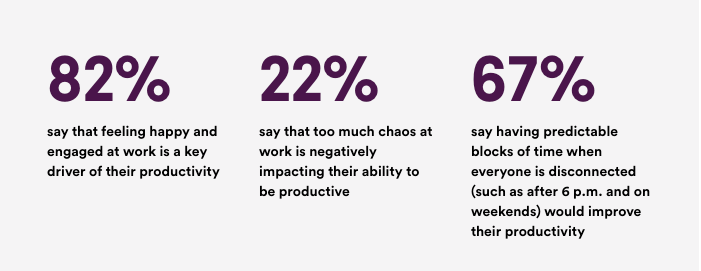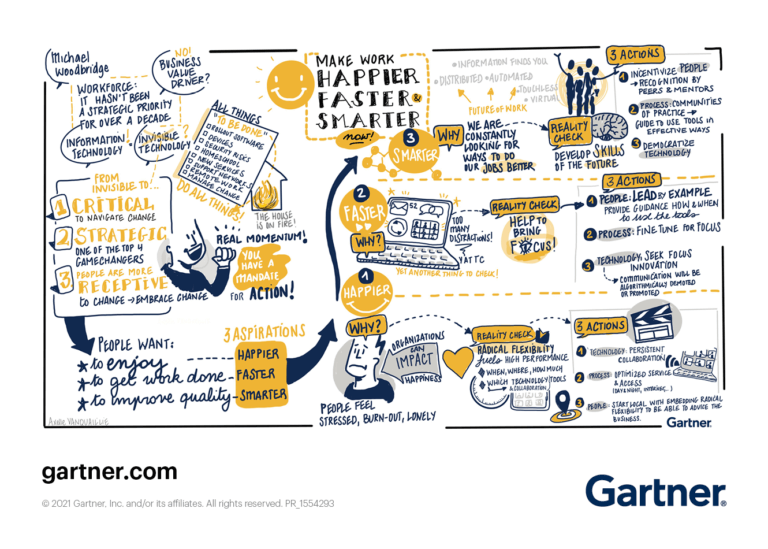What is a Digital Workplace?
Imagine a workplace where everything you need is at your fingertips—no matter where you are. No physical desks, no paper trails—just a seamless digital environment where your tools, documents, and conversations all exist online.
For modern businesses, adopting a digital workplace isn’t just convenient—it’s a game-changer. It allows teams to remain agile, productive, and aligned, even when they’re spread across different time zones. It’s no surprise that businesses that embrace digital transformation often see a boost in efficiency, collaboration, and employee satisfaction. In fact, it’s a crucial step for staying competitive in today’s fast-paced, tech-driven world.
Just like going paperless has become the norm, embracing a digital workplace is quickly becoming the next frontier in improving productivity and employee experience. By integrating the right tools, like AI-driven solutions or collaborative platforms, businesses can reduce information overload and create more streamlined, efficient processes.
Core Components of a Digital Workplace Strategy
Creating a successful digital workplace strategy isn’t just about choosing a few tools and calling it a day. It’s about designing an ecosystem that allows your employees to work efficiently, no matter where they are. Here are the core components every digital workplace strategy should include:
- Communication Tools: Keeping your teams connected is essential. Whether it’s messaging platforms like Slack or video conferencing tools like Zoom, your digital workplace must prioritize seamless communication across the board. These tools help break down silos and allow teams to stay in sync in real time.
- Collaboration Platforms: A solid collaboration system is the backbone of any digital workplace. Tools like SOP software enable real-time cooperation on documents, projects, and knowledge sharing. Employees should be able to access and work on company resources from anywhere.
- Project Management Tools: Managing workflows digitally is crucial for keeping projects on track. Tools like Asana, Trello, or Jira provide visibility into what tasks need to be done, by whom, and by when. These platforms help streamline team coordination and enhance overall productivity.
- Cloud Storage and Data Access: Secure, centralized cloud storage solutions such as Google Drive or Dropbox ensure that important company data is accessible from anywhere, while also safeguarding it. A cloud-based approach ensures that employees always have access to the latest versions of documents and resources.
- Security and Compliance: As the workplace becomes more digitized, keeping company data secure becomes a top priority. Implementing strong cybersecurity measures protects against data breaches, and ensuring your business adheres to compliance standards is non-negotiable. Think two-factor authentication, encryption, and routine security training.
Employee Engagement and Well-Being: At the heart of a successful digital workplace is a commitment to employee engagement. Tools that enhance collaboration, recognition platforms like Workplace by Facebook, and policies that promote well-being create a culture where employees thrive.
Why Businesses Are Adopting Digital Workplace Solutions
There’s been a major shift in how businesses operate, and the adoption of digital workplace solutions is at the heart of this change. But what’s driving this shift, and why are so many companies embracing digital workplaces?
- The Rise of Hybrid and Remote Work: The COVID-19 pandemic accelerated the need for remote and hybrid work environments. Now, businesses have recognized that employees can be just as productive—if not more so—when they work outside traditional office settings. Digital workplaces provide the infrastructure for this new way of working, allowing teams to stay connected no matter where they are.
- Increased Productivity: With the right digital tools in place, employees can access the information and resources they need instantly. This leads to fewer delays and less downtime, meaning employees can get more done, faster. By streamlining processes with AI-powered tools and better knowledge-sharing systems, businesses see a significant boost in efficiency.
- Cost Savings: Digital workplace solutions often lead to cost reductions. With less reliance on physical office space, travel, and printed materials, businesses can save on overhead costs. Additionally, automated processes and streamlined workflows reduce the need for manual labor, freeing up time and resources for more strategic tasks.
- Enhanced Collaboration: One of the key benefits of adopting a digital workplace is the ability to foster better collaboration. Whether your team is spread across the country or the globe, digital collaboration tools like Happeo or Quip allow employees to work together as if they were in the same room.
- Attracting Top Talent: Today’s workforce values flexibility. Offering a digital workplace solution means businesses can recruit from a larger, more diverse talent pool. Plus, the ability to offer remote or hybrid work environments is a huge draw for talent who prioritize work-life balance.
- Future-Proofing: As businesses prepare for the future, they need to be adaptable. Digital workplaces not only help companies stay competitive, but they also future-proof organizations by ensuring they can quickly pivot and adjust to new challenges. Whether it’s embracing AI tools or enabling mobile workforces, a digital workplace solution makes companies more agile and resilient.
Why HR Leaders Must Stay Ahead of Digital Workplace Trends
As digital workplaces evolve, it’s critical for HR leaders and business owners to stay on top of the latest trends and tools to maximize their workforce’s potential. Embracing digital transformation not only improves productivity but also enhances employee experience. For those looking to future-proof their workplace, understanding the role of AI and automation is essential.
Download the whitepaper to learn how AI and automation can revolutionize onboarding and training, empowering your workforce for tomorrow.
Benefits of a digital workplace
The advantages of a digital workplace are numerous:
- Increased Productivity: Employees can access necessary tools and information from anywhere, leading to less downtime and more efficient work processes.
- Cost Savings: Reduced need for physical office space and resources can lead to significant cost reductions.
- Flexibility: Employees enjoy greater work-life balance with the ability to work remotely.
- Improved Collaboration: Digital tools facilitate better communication and collaboration across teams and geographies.
- Employee experience: Greater collaboration results in better employee experience and engagement—and productivity, too! 82% of employees say that feeling happy at work drives productivity.
How to Promote Well-Being in a Digital Workplace
Balancing digital efficiency with employee well-being is crucial. Overloading teams with tech can lead to burnout, so it’s important to prioritize their mental and physical health alongside productivity. Start by promoting a culture of work-life balance. Encourage regular breaks, flexible working hours, and set clear boundaries to prevent work from spilling into personal time. Using wellness platforms like Headspace or providing access to virtual wellness programs can support mental health.
Additionally, create opportunities for social interaction through virtual team-building activities or casual chat channels in platforms like Slack. This fosters a sense of connection and helps reduce feelings of isolation, particularly for remote teams.
Common Challenges of Shifting to a Digital Workplace
Transitioning to a digital workplace can be transformative, but it’s not without its challenges. Businesses often face employee resistance, as new tools and processes can feel overwhelming. To overcome this, focus on change management—communicate the benefits clearly and provide comprehensive training to ease the transition.
App overload is another common issue. With too many tools in play, employees may experience tech fatigue. Streamline your toolset to ensure simplicity and efficiency. Additionally, cybersecurity concerns rise as more data moves online, so it’s essential to invest in secure digital infrastructure and provide regular training on safe practices.
By addressing these challenges head-on, businesses can navigate the shift to a digital workplace with greater ease and success.
How to choose the right tools and technologies
Selecting the right tools is crucial for the success of a digital workplace.
Before considering any new technology, it’s important to consider the implications for the business and its people.
- What is the potential ROI of such a tool
- AND what is the impact on the people working in the organization.
More specifically will a new tool;
- Reduce operational costs,
- Increase revenue,
- Accelerate time to market,
- Increase agility and flexibility,
- Better the employee experience,
- Raise productivity,
- Strengthen talent retention,
- Or make innovation easier?
Once you understand the answers to those questions, consider the following elements when considering tools;
- Scalability: Choose tools that can grow with your business.
- Integration: Ensure the tools can integrate with your existing systems and processes.
- User-Friendliness: Opt for tools that are intuitive and easy for employees to use.
- Support: Look for vendors that offer robust customer support and training resources.
Got questions on your mind?
Book a demo with our team today!
Is a digital workplace the solution for your business?
A digital workplace can offer substantial benefits, but it’s essential to consider its impact on your business and employees. While it can enhance flexibility and productivity, it can also lead to challenges such as burnout if not managed properly.
According to a study by Buffer, 22% of remote workers struggle with unplugging after work, highlighting the importance of establishing boundaries and promoting a healthy work-life balance.
Example of a Digital Workplace Strategy
Company snapshot: With ~18,000 employees, RehabCare provides rehab and post-acute care services, operating in over 1,200 hospitals and facilities across 43 states.
The Challenge:
At RehabCare, every minute counts – employees need to track and record every detail, including the diagnosis, treatment and when the appointment began and ended.
The digital workplace solution:
RehabCare equipped its staff with easy-to-use, process-driven applications on iPhone and iPad mobile devices. The mobile devices are used at point-of-care to capture information quickly and easily, such as the treatment delivered, the time spent and other relevant clinical information. The cloud-based applications allow access to detailed patient information anytime anywhere.
Key benefits:
The devices offer an intuitive user interface that requires minimal training and appeals to employees.
RehabCare estimates it is saving millions per year in job retention as a result of iPhone and iPad integration. Before this integration, patient pre-admission screening was a time-consuming process involving multiple paper forms and questionnaires.
Source: Apple Inc.6
Winning strategies to shift to a digital workplace
If you’ve decided to make the shift to a digital workplace, make sure to follow these best practices;
- Involve stakeholders across the organization to ensure a complete and solid digital strategy
- Consider employee roles both now and for the future and ensure adequate employee training
- Consistently run process audits to ensure best outcomes
- Test and utlize AI tools but make sure to evaluate the ROI
- Get employee feedback for continuous improvement

Impact of a digital workplace on people in the business
The digital workplace has the potential to impact team members positively but also negatively.
As such it’s important to consider the impact of new tools on team members. There is a risk of burnout due to the blurring of work-life boundaries. It’s crucial to implement policies that encourage regular paid time off and general work-life balance.
Bottom line?
The digital workplace represents the future of work, offering numerous benefits for businesses and employees alike. By carefully selecting the right tools, developing clear policies, and addressing challenges proactively, businesses can successfully transition to a digital workplace.
Ultimately, the goal is to create an environment that supports productivity, innovation, and employee well-being. The key to success lies in balancing technology with human needs to create a harmonious and effective workplace.
FAQs on Digital Workplace Strategy
What are the 5 pillars of digital workplace strategy?
There are five main pillars to consider in digital workplace strategy;
- Technology
- Content
- Collaboration
- Compliance
- Experience.
What is an example of a digital workforce?
A digital workforce refers to employees who leverage technology to perform tasks from any location. For example, a sales team using cloud-based CRM software like Salesforce to manage leads, collaborate via Slack, and analyze data through AI tools demonstrates a digital workforce. They access tools and data remotely, communicate in real-time, and automate routine tasks, enabling flexibility and efficiency without being tied to a physical office.
What is the difference between digital workspace and workplace?
A digital workspace is like your personal virtual desk—it includes the apps and tools you need to complete specific tasks, like task management or file sharing. In contrast, a digital workplace is a broader, organization-wide environment that integrates all the tools, data, and processes employees need to collaborate, communicate, and complete work across various workspaces. In essence, a digital workplace is a virtual office, while a digital workspace is a personal or task-specific workstation within that office.
What is the digital workplace framework?
A digital workplace framework is the structure that integrates all the digital tools, processes, and resources employees need to work efficiently, whether on-site or remotely. It includes essential components like communication tools, HR systems, collaboration platforms, and project management software. The framework unifies everything in a secure, accessible environment, allowing employees to communicate, share files, and collaborate seamlessly. By supporting flexibility, transparency, and automation, the digital workplace framework enhances productivity, streamlines operations, and improves the overall employee experience.









